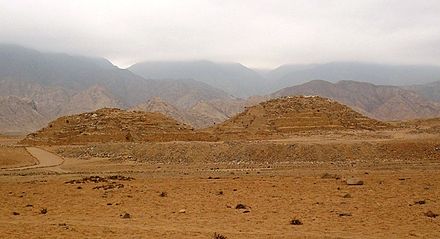Caral - large archaeological site in Peru where the most ancient city of the America's stood, UNESCO World HERITAGE site

Understand
The Sacred City of Caral-Supe is the oldest civilisation found in South America, dating from roughly 3000 B.C. about the same age as Mesopotamian and Egyptian civilisation. Near the reception of the site, there is a centre of interpretation but text is Spanish only. Most signboards and explanation boards elsewhere on the site are both Spanish and English. The site mostly comprises about 18 ruins of pyramids and other structures, of which 7 large pyramids are the star attraction.
The 66 ha site has become under threat by land developers during the 2020 Covid pandemic, and reduced security has led to some of the site's heritage being destroyed to make room for avocado and fruit trees. There were also reports of looting of archaeological artefacts, including mummies.
Along the Rio Supe valley, near the Caral-Supe site are other archeological sites (not UNESCO heritage inscribed, some barely visible on satellite image and difficult to access) of settlements contemporary to Caral-Supe, including:
- Llaqta
- Allcapoto
- Cerro Colorado
- (Sitio arqueologico) Pueblo Nuevo
- (Sitio arqueologico) Pando
- Era de Pando
- Liman - not placemarked on Google maps yet
- Pampa de los Geoglifos de Caral
- Piedra Parada
- Chupacigarro
- (Sitio Arqueológico) El Áspero - with site museum, access from Supe-Puerto, turn off main road then 2.1km / 27min if walking
- Rurihuasi
- Lurihuasi
- Miraya
Of these, Rurihuasi, Lurihuasi, Chupacigarro and Miraya are adjacent to Caral-Supe site, along the south bank of river Supe.
further afield are:
- (Sitio Arqueológico) Vichama, 27km south-west from Caral
- (Zona arqueologica monumental) Los Huacos
- (Zona Arqueológica en) Centinela and Centinela II
- (Zona Arqueológica de la Cultura) Chancay
Get in
Full-time transport from Lima is about 5–6 hours one-way, especially if going by public transport.
The nearest sizeable town with good amenities is Barranca. From Barranca take minibus (numerous and frequent, cost S/ 2.50) to Supe, at Centro Supe (corner with Jiron La Mar) take combi to Caral (23 km, S/6 soles) to Caral settlement, walk 1.2km to pedestrian bridge (puente peatonal, crossing Rio Supe), then further 1.7km to reach site entrance (museum).
By car
From the south, after Tiroles, turn right off Panamerica Norte onto Desvio Caral, then 22km to Museo sitio Caral.
From the north, at major junction after Supe, turn off Antigua Panamericana Norte onto road 102 (Carretera Caral-Las Minas-Ambar) eastward toward Caral, turn right at Caral settlement, then 1.2km to reach car park, then walk 1.6km (including crossing pedestrian bridge) to reach Museo sitio Caral.
Alternatively it is possible to drive cross Rio Supe during dry season (May to November) via road 102 then turn off into Acceso Caral, then 3.7km to reach Museo sitio Caral from the west, this avoids walking.
By public transport
To get in from Barranca, take a minibus to Supe (or Barranca) with one of the following:
- Turismo Barranca, Av Abancay 900, Centro Historico, Lima, +51 7810551. 15 soles
- Turismo Paramonga, 251 Javier Luna Pizarro, La Victoria, Lima (near Via Expresa Grau and Estado Nacional), +51 4236338. 15 soles
By tours
Tours leave from Lima on weekends only, but the trip is around 3 hours each way by tour (longer as independent) and makes for a long day. These buses usually come in from the highway turning off at Vegeta.
Archeological site organized visit for about 90 sol from 'Puerta principal del Museo de la nacion (Av Javier Prado Este 2465, San Borja, East of San Isidro). see website (Spanish only) for more.
Get around
There are other archeological sites around that you can visit too if you are on a tour or with your own vehicle.
Do
- Ciudad sagrada, -10.8925°, -77.5223°. 09:00 - 16:00. You must be always accompanied either by a guide or somebody of the staff to ensure respect of rules and preservation of the site. Note than geoglifo/chupacigarro area is not opened to visitors. 11 soles (adult), 4 soles (students), 1 sol (primary school), 20 soles (group guide)
Buy
Eat
There is little food stalls or shop on archeological site (at reception and near the bridge), more on week-ends than during week. Caral has few places to eat and some street stalls. Supe has a small market.
Drink
Sleep
Options are limited but it seems possible to sleep in Caral (but probably limited choice and not any kind of budget). Supe is said to be avoided. Else It's better to stay at Barranca. If you are not sleeping around, there is no given place to store luggages. You can ask at bus counter or archeological site entrance if possible to keep bags if needed.
Stay safe
Caral is in a green area but archeological site is in a desert one and can be very sunny. It's advised to have water, hat and sunscreen. Outside of reception, there is no shelter to rest or get some shadow, so be prepared.
Go next
Can only leave through Supe or Barranca to Lima and possibly Chimbote or Trujillo.
Barranca
2nd-order administrative division
Lima region
Primary administrative division